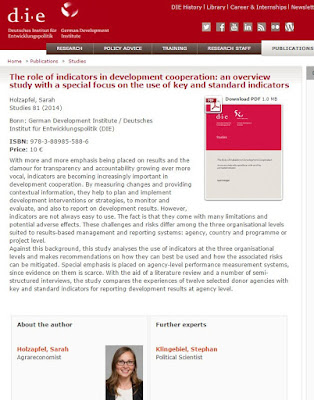by Greg Armstrong
[Updated October 2018]
International aid agencies sometimes try to use standard performance indicators to make aggregation of agency-level results easier, but there are real dangers in using these at the project level as Sara Holzapfel explains in her detailed report The Role of Indicators in Development Cooperation
Level of Complexity: Complex
Length: 236 pages (the full version, 38 pages for an earlier discussion paper)
Languages: English
Primarily Useful for: Agency-level RBM experts
Most Useful: Comparisons of how aid agencies use standard indicators at different results levels - particularly Appendix A5, p. 205-233.
Limitations: Realistically, there are no quick answers on how to aggregate project-level results without using standard indicators
[Updated October 2018]
International aid agencies sometimes try to use standard performance indicators to make aggregation of agency-level results easier, but there are real dangers in using these at the project level as Sara Holzapfel explains in her detailed report The Role of Indicators in Development Cooperation
Level of Complexity: Complex
Length: 236 pages (the full version, 38 pages for an earlier discussion paper)
Languages: English
Primarily Useful for: Agency-level RBM experts
Most Useful: Comparisons of how aid agencies use standard indicators at different results levels - particularly Appendix A5, p. 205-233.
Limitations: Realistically, there are no quick answers on how to aggregate project-level results without using standard indicators
Background
Many of us have encountered development projects where, in the attempt to demonstrate agency-wide accountability for results the aid agency designing the project has moved away from project-specific results indicators which measure capacity development, policy change or changes in implementation, and attempted to use agency-level standard indicators at the project level.
As Sara Holzapfel notes in her detailed assessment of how aid agencies use standard performance indicators, published by the: German Development Institute this trend has arisen both from a concern with accountability and a real interest in whether development programmes contribute to agreed upon goals.
“Amid rising criticism of aid effectiveness coupled with tight budgets in many traditional donor countries at a time of economic crisis, donor agencies are under pressure to deliver more value for money and to provide evidence of the positive effects of development cooperation. In response to these pressures, more and more development agencies are adopting agency results frameworks for monitoring and managing their progress in pursuing their strategic objectives and for reporting on performance.”
Even where there is apparent, substantial progress on broad, long-term indicators, such as the millennium development goals questions still remain about whether the indicators for these goals, themselves, can tell us anything about whether development interventions contribute effectively to long term results, whether the indicators describe progress against problems effectively and as a 2014 report on MDG targets and indicators for human development and human rights published in the Journal of Human Development and Capabilities noted
“The unintended consequences revealed in the Project cannot merely be ascribed to the goals and targets having been selected or implemented badly, as is sometimes claimed. They are more fundamental structural issues arising from the nature of quantification and the nested structure of goals, targets and indicators that the MDGs created.”







